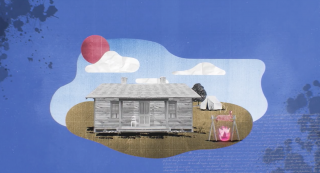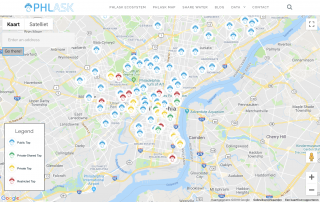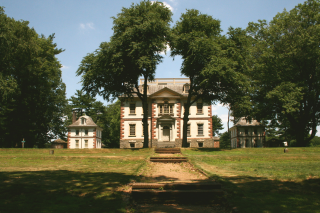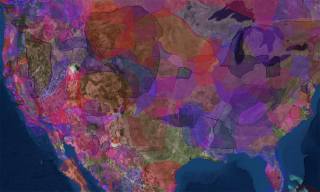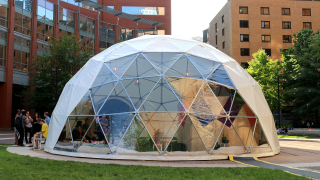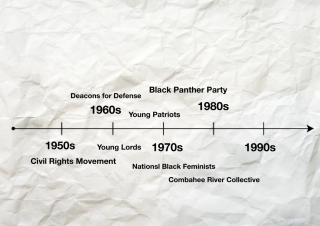Organize Your Own Temporality: Notes on Self-Determined Temporalities and Radical Futurities in Liberation Movements By Rasheedah Phillips
Footnotes:
1 Early on, many of us are taught to map out major events, world history, and even our own lives onto a timeline that runs from past to present to future. The timeline typically looks something like a straight line, with major events representing points on the timeline, where time comes from behind us and moves forward. The straight line moving from past to future also represents cause and effect.
2 Wright, Michelle M. Physics of Blackness: Beyond the Middle Passage Epistemology (Minneapolis: University of Minnesota Press, 2015), p. 57.
3 McAdam, Douglas and William H. Jr. Sewell, “It’s About Time: Temporality in the Study of Social Movements and Revolutions,” in Aminzade, et al., eds., Silence and Voice in the Study of Contentious Politics (Cambridge University Press, 2001), p. 112.
4 It is important to note that temporal-spatial traditions varied widely across cultures, countries, groups, and individuals across Indigenous Africa, but that the observations presented in this essay are based on extensive research on space, time, and spiritual traditions of a number of African cultures and groups that yield basic generalizations and assumptions.
5 A Comparison of the Western and African Concepts of Time.
6 A Comparison of the Western and African Concepts of Time.
7 Fisher, Jerrilyn. “Teaching ‘Time’: Women’s Responses to Adult Development,” in Taking Our Time: Feminist Perspectives on Temporality, p. 137.
8 Femalear Explorations: Temporality in Women’s Writing, in Taking Our Time: Feminist Perspectives on Temporality, p. 162.
9 Wright, Michelle M. “Physics of Blackness: Beyond the Middle Passage Epistemology” (Minneapolis: University of Minnesota Press, 2015), p. 56.
10 Wallace, Amy. “War of the Worlds,” Wired (November 2015), p. 97.
11 Butler, Octavia E. Bloodchild and Other Stories (New York: Seven Stories Press, 2005; second edition), p. 134–35.
12 Metropolarity Journal of Speculative Vision and Critical Liberation Technologies (March 2013), Season 1, Episode 1 (zine).
2 Wright, Michelle M. Physics of Blackness: Beyond the Middle Passage Epistemology (Minneapolis: University of Minnesota Press, 2015), p. 57.
3 McAdam, Douglas and William H. Jr. Sewell, “It’s About Time: Temporality in the Study of Social Movements and Revolutions,” in Aminzade, et al., eds., Silence and Voice in the Study of Contentious Politics (Cambridge University Press, 2001), p. 112.
4 It is important to note that temporal-spatial traditions varied widely across cultures, countries, groups, and individuals across Indigenous Africa, but that the observations presented in this essay are based on extensive research on space, time, and spiritual traditions of a number of African cultures and groups that yield basic generalizations and assumptions.
5 A Comparison of the Western and African Concepts of Time.
6 A Comparison of the Western and African Concepts of Time.
7 Fisher, Jerrilyn. “Teaching ‘Time’: Women’s Responses to Adult Development,” in Taking Our Time: Feminist Perspectives on Temporality, p. 137.
8 Femalear Explorations: Temporality in Women’s Writing, in Taking Our Time: Feminist Perspectives on Temporality, p. 162.
9 Wright, Michelle M. “Physics of Blackness: Beyond the Middle Passage Epistemology” (Minneapolis: University of Minnesota Press, 2015), p. 56.
10 Wallace, Amy. “War of the Worlds,” Wired (November 2015), p. 97.
11 Butler, Octavia E. Bloodchild and Other Stories (New York: Seven Stories Press, 2005; second edition), p. 134–35.
12 Metropolarity Journal of Speculative Vision and Critical Liberation Technologies (March 2013), Season 1, Episode 1 (zine).
Half the land in Oklahoma could be returned to Native Americans. It should be.
A Supreme Court case about jurisdiction in an obscure murder has huge implications for tribes.
By Rebecca Nagle, The Washington Post
Rebecca Nagle is a writer, advocate and citizen of Cherokee Nation living in Tahlequah, Okla.
The Washington Post article
read further...
By Rebecca Nagle, The Washington Post
Rebecca Nagle is a writer, advocate and citizen of Cherokee Nation living in Tahlequah, Okla.
The Washington Post article
read further...
PHLASK Project - find water map
The PHLASK Project was conceived as a social enterprise solution to help make an existing system - accessing and drinking water - more ecologically sustainable.
The mission of the project was to reimagine how existing infrastructures and systems could be reorganized and optimized to reduce waste and provide greater access to water, simply by re-engineering the social norms of accessing existing water sources.
by Billy Hanafee
Find water map
read further...
The mission of the project was to reimagine how existing infrastructures and systems could be reorganized and optimized to reduce waste and provide greater access to water, simply by re-engineering the social norms of accessing existing water sources.
by Billy Hanafee
Find water map
read further...
North Philly Teach-in: Changing the Master Narratives, November 10, 2018, Mount Pleasant Mansion, By Denise Valentine
North Philadelphia has undergone rapid and significant changes over the last 2-1/2 centuries. While facing a history of discriminatory housing policies, strategic decay and displacement, African-Americans have raised families, created community, made their mark and changed the course of history. In recent decades, archival material has been uncovered revealing the lives of Africans enslaved at several Fairmount Park Mansions. What are their stories? If we don't remember them who will? If we don't tell these stories who will? And, who will remember us when we are gone?
read further...
read further...
This App Can Tell You the Indigenous History of the Land You Live On
Whose land are you on? Start with a visit to native-land.ca. Native Land is both a website and an app that seeks to map Indigenous languages, treaties, and territories across Turtle Island. You might type in New York, New York, for example, and find that the five boroughs are actually traditional Lenape and Haudenosaunee territory.
read further...
read further...
Sanctuary Directory
The Sanctuary Directory, compiled by PHLA collaborators is showing different community partners included: The Attic Youth Center, Project SAFE, Prevention Point, Laos in the House, New Sanctuary Movement, Broad Street Ministry and other organizations on sanctuary related services throughout the city.
read further...
read further...
